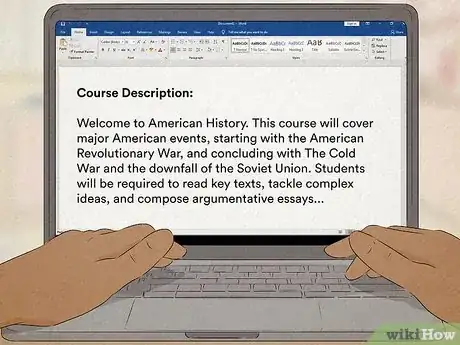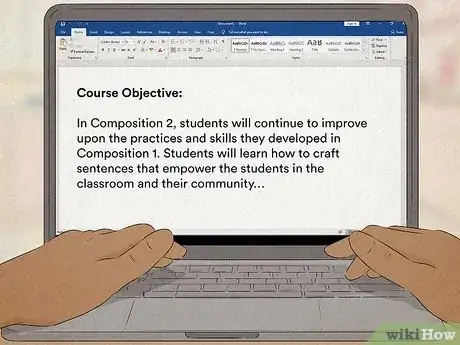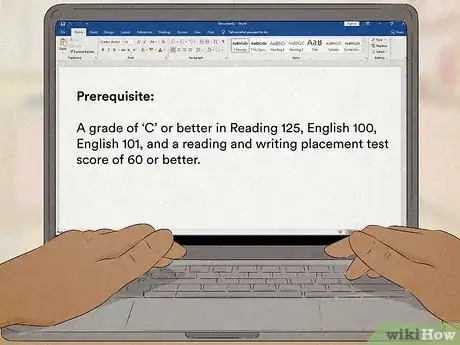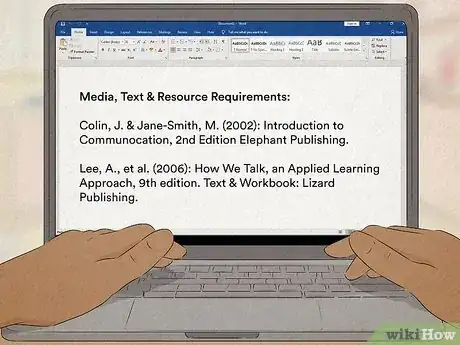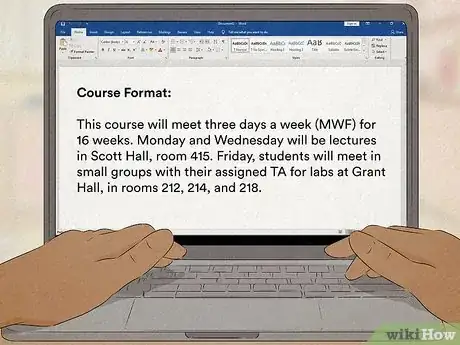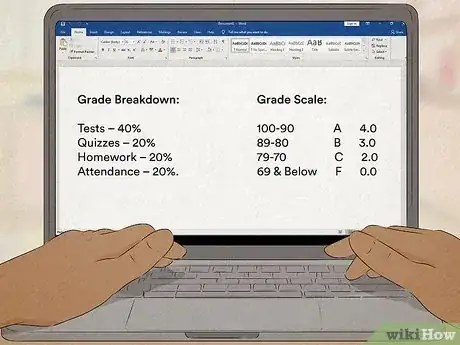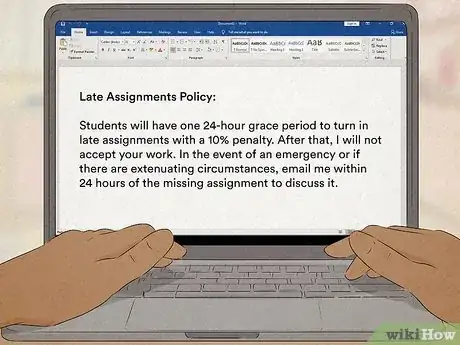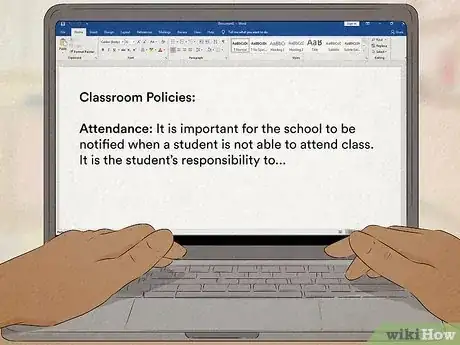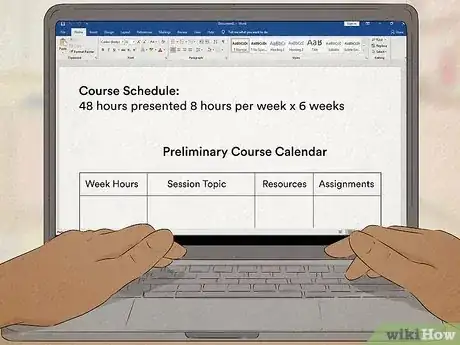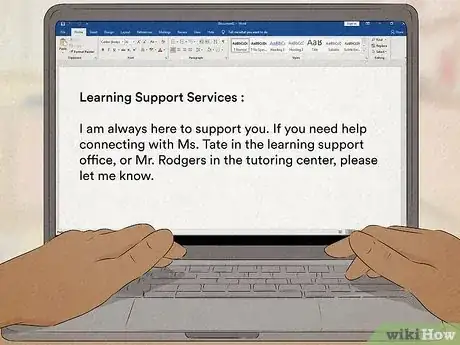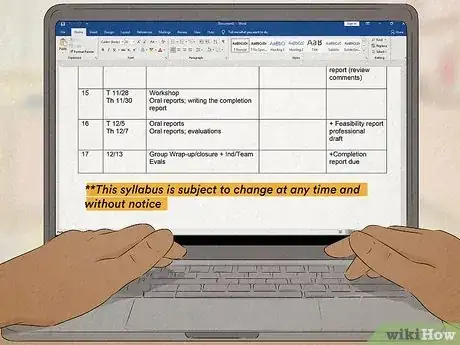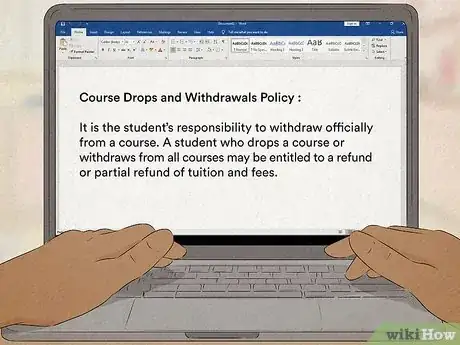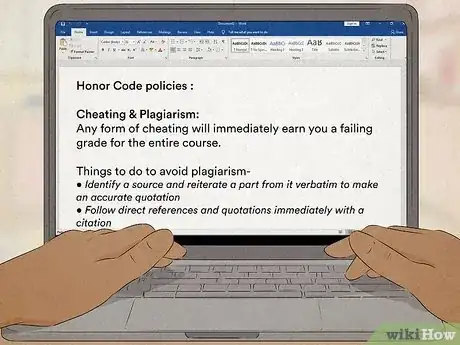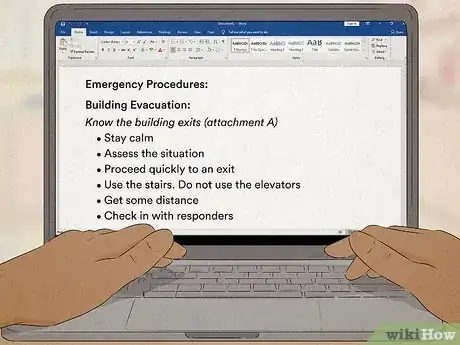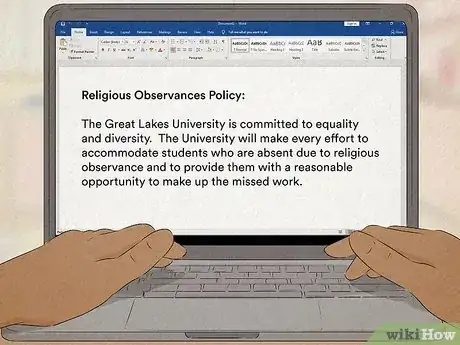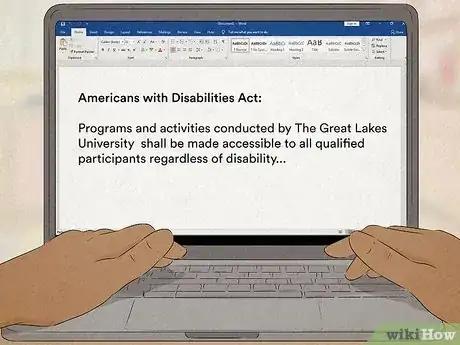This article was co-authored by Emily Listmann, MA and by wikiHow staff writer, Eric McClure. Emily Listmann is a private tutor in San Carlos, California. She has worked as a Social Studies Teacher, Curriculum Coordinator, and an SAT Prep Teacher. She received her MA in Education from the Stanford Graduate School of Education in 2014.
There are 17 references cited in this article, which can be found at the bottom of the page.
wikiHow marks an article as reader-approved once it receives enough positive feedback. In this case, several readers have written to tell us that this article was helpful to them, earning it our reader-approved status.
This article has been viewed 133,233 times.
A syllabus is an important document that will help your students know what to expect in your class. It also serves as a guide for administrators, and can help you think about your class from a big picture perspective. If this is your first time writing a syllabus, ask the head of your department or your principal to see if there’s anything your school requires you to put in your syllabus before you start. Then, read on and follow these steps to add everything you’d ever need to include on your syllabus.
Steps
Including Key Information
-
1Put your name, email, and class info at the top. Include the time or period that your class meets, the room you’ll meet in, the title of the course, and your email. Drop the date or semester at the end. This way, your students and their parents will have quick access to the key information they’ll need to reference.[1]
- Type the title of your course at the top of the document. You can follow this by (next to or underneath) the semester, year, and section number of the course.
- You can include your office phone number if you have one, but don’t give out your cell phone.
- You might write “English 102—World Literature / Mr. Jones, mjones@school.edu / Room 214, Period D / Fall 2022”
-
2Include a short course description at the top. In 4-6 sentences, describe what your class will cover. Reference some of the texts or topics you’re going to teach, and explain what students will need to do in order to be successful in your class. This way, anyone can look at your syllabus and form a basic understanding of what your course covers.[2]
- Note what kind of assignments students will complete (i.e. quizzes, discussion boards, or lab assignments).
- You might write: “Welcome to American History. This course will cover major American events, starting with the American Revolutionary War, and concluding with The Cold War and the downfall of the Soviet Union. Students will be required to read key texts, tackle complex ideas, and compose argumentative essays...”
Advertisement -
3Outline the objectives for the course. Course objectives will give students a sense of what they will accomplish while in the class. Objectives might be super specific if you’re teaching an advanced college course, or more general if you’re teaching an introductory high school class.[3]
- You can say something like, “In Composition 2, students will continue to improve upon the practices and skills they developed in Composition 1. Students will learn how to craft sentences that empower the students in the classroom and their community…”
-
4List any prerequisites that are required for your course. These are the courses, content, or other qualifications a student must have to take your class. If the course has any prerequisites, list them near the top of the syllabus. This can come before the course objective and description or after.[4]
- If you’re teaching a mandatory class for middle or high school students, or you’re teaching a survey course with no prerequisites, feel free to skip this section.
- Just include a list of the required courses, like, “A grade of ‘C’ or better in Reading 125, English 100, English 101, and a reading and writing placement test score of 60 or better.”
-
5Include a list of the required materials for the course. This list should include books, hardware, software, art supplies, and more. If you’re teaching a grade- or middle-school level course, include every supply your students will need—even the obvious stuff, like pens and pencils.[5]
- Provide students with the name, author, year, and International Standard Book Number (“ISBN”) of the textbooks, novels, or coursebooks students will need.
- You don’t need to list materials required by every class, such as notebooks, paper, or pens if you’re teaching a high school or college class.
- A good rule of thumb is to include any materials not common to other classes, such as a scientific calculator, software, or drafting tools.
-
6Compose a few short sentences on the format of the class. Mention the organization of the course near the start of the syllabus. This statement will tell students how course content will be delivered. Feel free to skip this one if you’re teaching a normal high or middle school class that meets daily.[6]
- Mention how the course is taught (through lectures, labs, or online video lectures).
- Depending on your style and/or the customs of your institution, you may want to include this in your course description.[7]
- You might write, “This course will meet three days a week (MWF) for 16 weeks. Monday and Wednesday will be lectures in Scott Hall, room 415. Friday, students will meet in small groups with their assigned TA for labs at Grant Hall, in rooms 212, 214, and 218.”
Outlining Your Policies
-
1Describe your assessment measures and grading policy. Include a section on how you’re evaluating students and assigning grades. This section of a syllabus tells students how the major components of the class contribute to their final grade.[8]
- Many institutions have specific rules about what should be included in this section, so check with the administrator or department for guidelines on what must be included.
- Include your grading scale. For instance, an A equates to a 90% to 100%, a B equates to an 80% to 89%, and so on and so forth.
- Provide a statement about any other grade policies, such as if you drop the lowest test or quiz grade.
- You might say: “Tests – 40%, quizzes – 20%, homework – 20%, attendance – 20%.”
-
2Include a late, missed, and incomplete assignment policy. Immediately after the evaluation policy section, compose a section that details what happens if a student is late with their work. You normally have some freedom here, but talk to your department head to see if there are any requirements here. Schools occasionally have rules on this.[9]
- Include an explicit statement about makeup exams for sick days or emergencies.
- You could say, “Students will have one 24-hour grace period to turn in late assignments with a 10% penalty. After that, I will not accept your work. In the event of an emergency or if there are extenuating circumstances, email me within 24 hours of the missing assignment to discuss it.”
-
3Outline your classroom policies—in detail for younger students. This includes rules and behavioral/academic expectations. This section will give your students a good idea of how they need to conduct themselves while in your classroom or while engaging in coursework.[10]
- Many colleges and universities have specific policies and statements that must be included in this section of the syllabus, so check with the appropriate educational institution for guidelines.
- Attendance policy. Most educational institutions have a school-wide attendance policy which you may want to include in your syllabus.
- Class participation policy. Describe exactly how students should participate and what their participation will mean to their grade.
- Classroom etiquette. Be sure to spell out the policy on eating and drinking in class, using a cell phone or laptop during class, talking to other students while the instructor is speaking, etc.[11]
-
4Provide a course schedule so students know key dates. Your calendar or schedule will outline how where the class will be, content and assignment wise, throughout the semester or year. If your department allows it, you can simply provide a weekly guide on the topics you will cover as a class.[12]
- Include the dates of key assignments and final exams if you have them.
- If it’s your first time teaching this class, you may not have completed unit or lesson plans. In that case, talk to your department head. They likely won’t require a schedule.
Adding Required Institutional Info
-
1Inform your students about learning support services at your institution. Every school offers learning support services to students. Whether it’s tutoring, counselling, or supports for students with disabilities, include your school’s services so that students can access what they need.[13]
- Your institution might require you to include language about learning support services, but check with your administrators.
- You might write, “I am always here to support you. If you need help connecting with Ms. Tate in the learning support office, or Mr. Rodgers in the tutoring center, please let me know.”
-
2Mention that you can change the syllabus without warning. One important line to include is a syllabus change policy. This will let students know that you have the right to change the syllabus throughout the term of the course. Just try to avoid changing big elements of your course, like the grading policy.[14]
- You could say, “This syllabus is subject to change at any time and without notice.”
- Teachers often put this line at the very bottom of the syllabus, but you can put it anywhere you’d like.
-
3Provide a statement on your school’s add/drop policy, if applicable. Post-secondary institutions may require you to add language about their withdrawal or add/drop policy. The add/drop policy will let students know when they can drop the class without academic penalty.[15]
- Include the last day they can drop your course without penalty.
- Include any other relevant information about your institution’s add/drop or withdrawal policy.
- Just copy and paste this from another teacher’s syllabus, or pull it directly from the student handbook.
-
4Address your institution’s honor code policy. Most educational institutions will require that you include a cheating or plagiarism statement that addresses their honor code policy. In this event, your institution will provide you with a copy of their honor code.[16]
- They may even provide you with a boilerplate section to add to your syllabus.
- Schools often have a concrete honor policy that you can’t change, but if you do want to add to it, include that info in your classroom policies section.
-
5Outline your institution’s emergency procedures, if required. You may be required to provide students with instructions for campus-wide emergencies. If you are, an administrator will give you a list of what to include. If they don’t, skip this one.[17] These procedures might include:
- What to do in the event of a lockdown.
- Procedures in case there is a bomb threat.
- Instructions on what to do if there is a fire.
Incorporating Legal Compliance Materials
-
1Mention the institution’s policy regarding religious holidays. Federal law prohibits discrimination based on religion. As a result, many secondary and post-secondary institutions have adopted a religious observance policy that protects the ability of students to miss school for religious holidays.[18]
- You may want to add language letting your students know that their right to observe religious holidays is protected. Check with your administration to see how/if they’d like you to address this.
- This material is often covered in the student handbook, so you may be asked to not include this in your syllabus.
-
2Address the American with Disabilities Act (ADA). Federal law requires that public institutions provide accommodations to people with disabilities. Because of this, your institution may require you to include a section in your syllabus that addresses the ADA, and explains how your institution offers accommodations.[19]
- Very often, students need to register with counseling or a disability resource center. Students should provide documentation of a recognized disability to the institution during the enrollment process or shortly thereafter.[20]
- Many schools will put this information in the student handbook, so check with your administration to see if you need to include it in your syllabus.
-
3Insert a section addressing federal privacy law, if applicable. College and university instructors may want to include language explaining the Family Educational Rights and Privacy Act (FERPA). FERPA governs the privacy of students and/or their parents, depending on age and the type of educational institution. If you are asked to include this, the administration will provide you with the statement to include.[21]
- FERPA states that instructors and others at a postsecondary institution cannot discuss a student’s grades, status, or attendance with anyone without their expressed written permission.
- FERPA applies to any student 18 or older, or any student attending a postsecondary institution.
- For students under the age of 18 at secondary institutions, FERPA rights lie with their parents or legal guardians.
References
- ↑ https://www.ncbi.nlm.nih.gov/pmc/articles/PMC2384173/
- ↑ https://sites.nd.edu/kaneb/2018/03/19/writing-a-course-description/
- ↑ https://teach.its.uiowa.edu/sites/teach.its.uiowa.edu/files/docs/docs/Goals_vs_Objectives_ed.pdf
- ↑ https://citl.illinois.edu/citl-101/teaching-learning/resources/teaching-strategies/creating-a-syllabus
- ↑ https://ctl.wustl.edu/resources/constructing-a-syllabus/
- ↑ https://ctl.wustl.edu/resources/constructing-a-syllabus/
- ↑ https://www.ulethbridge.ca/teachingcentre/constructing-course-outline-or-syllabus
- ↑ https://ctl.wustl.edu/resources/constructing-a-syllabus/
- ↑ https://www.cmu.edu/teaching/designteach/syllabus/checklist/lateworkpolicy.html
- ↑ https://citl.illinois.edu/citl-101/teaching-learning/resources/teaching-strategies/creating-a-syllabus
- ↑ http://www.ncbi.nlm.nih.gov/pmc/articles/PMC2384173/
- ↑ https://www.ncbi.nlm.nih.gov/pmc/articles/PMC2384173/
- ↑ https://accessiblecampus.ca/tools-resources/educators-tool-kit/course-planning/writing-a-course-syllabus/
- ↑ https://www.gwhatchet.com/2018/01/16/professors-need-to-keep-their-word-and-stick-to-the-syllabus/
- ↑ https://resources.uta.edu/provost/course-related-info/institutional-policies.php
- ↑ https://www.txstate.edu/honorcodecouncil/Reporting-Misconduct--Faculty/Syllabus-suggested-wording.html
- ↑ https://www.mtsac.edu/risk/documents/EmergencyPreparedness-SyllabusStyle.pdf
- ↑ https://teaching.pitt.edu/featured/religious-observances/
- ↑ https://beta.ada.gov/
- ↑ https://www.dol.gov/general/topic/disability/ada
- ↑ https://www2.ed.gov/policy/gen/guid/fpco/ferpa/index.html
- ↑ http://www.ncbi.nlm.nih.gov/pmc/articles/PMC2384173/
- ↑ http://www.ncbi.nlm.nih.gov/pmc/articles/PMC2384173/
About This Article
To write a syllabus, start by putting the course title, semester, year, and section number at the top of the page, followed by your name, the class location and meeting times, and your contact information. Next, write a course description that will give students a general idea of what the class will be about, its purpose, and the content. After the description, outline the course objectives, including what students will learn, what skills they’ll develop, or what questions they’ll answer. Then, list any required materials and grading policies. To learn how to include institutional and administrative language, keep reading!

